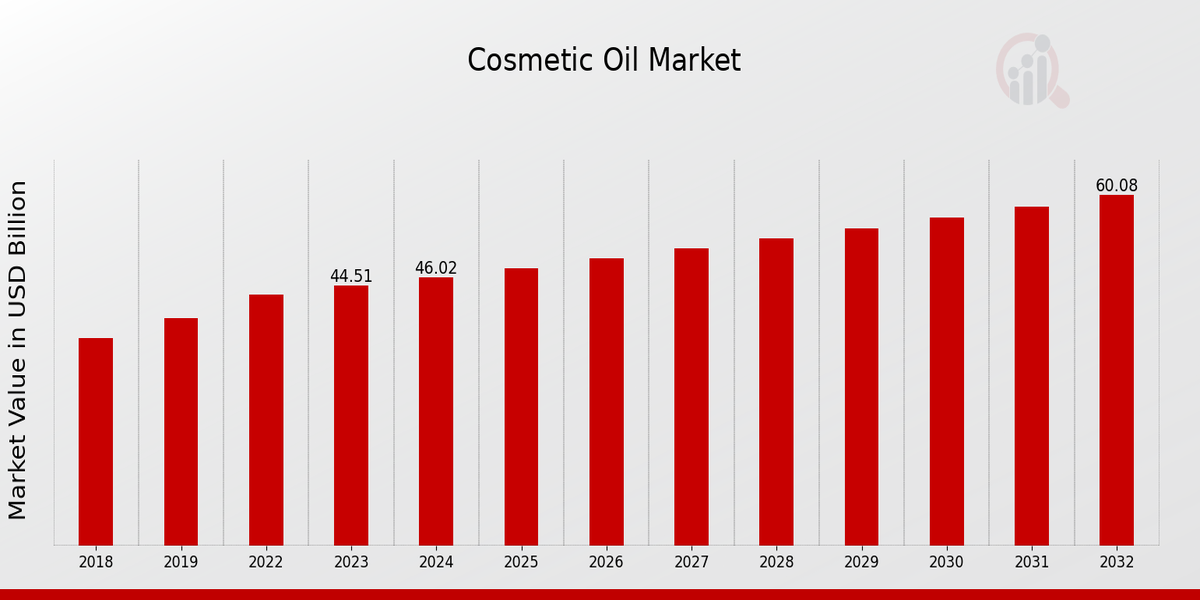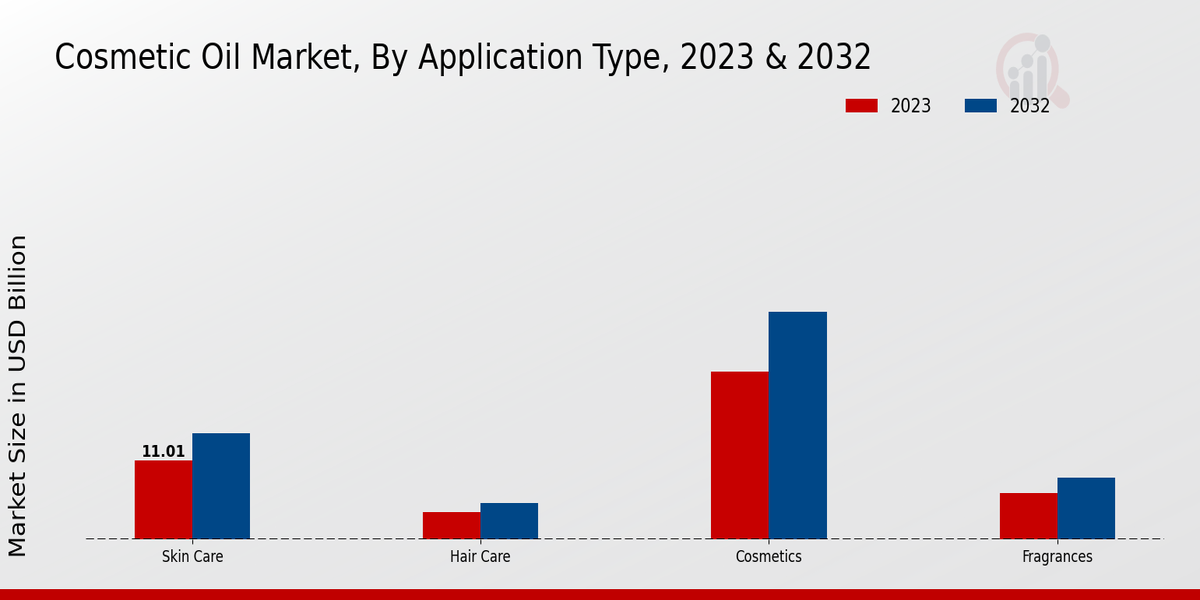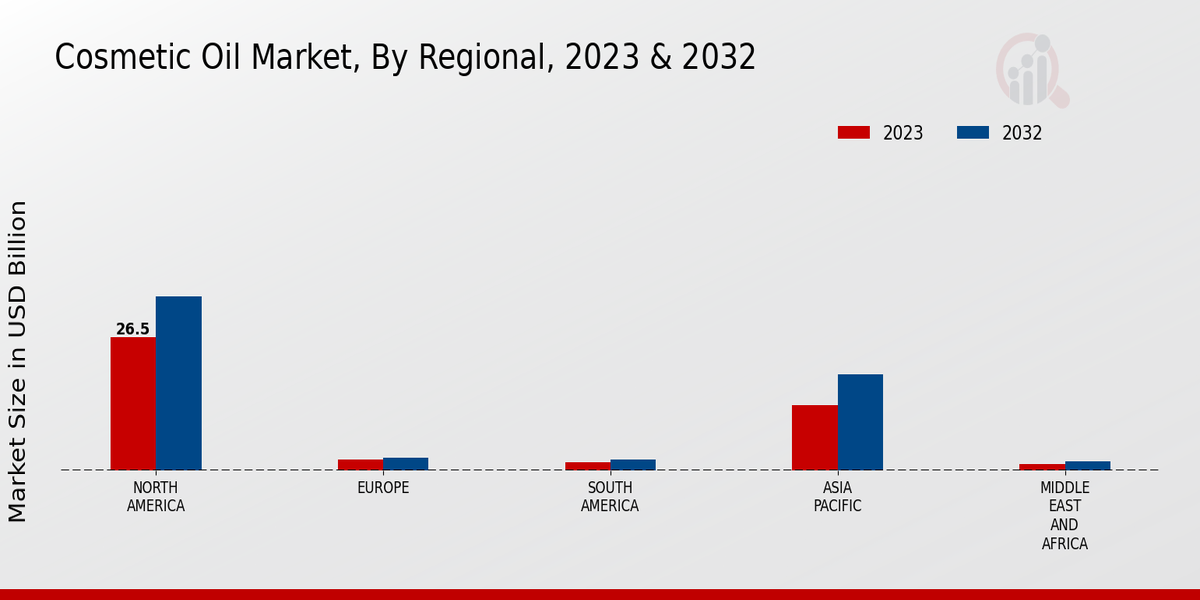Global Cosmetic Oil Market Overview
The Cosmetic Oil Market Size was estimated at 47.58 (USD Billion) in 2024. The Cosmetic Oil Industry is expected to grow from 49.20 (USD Billion) in 2025 to 66.42 (USD Billion) by 2034. The Cosmetic Oil Market CAGR (growth rate) is expected to be around 3.4% during the forecast period (2025 - 2034).
Key Cosmetic Oil Market Trends Highlighted
Growing consumer awareness of the advantages of natural and organic skincare products is fueling the cosmetic oil market's optimistic growth prospects.
These oils are in high demand, especially among millennial and Generation Z customers, who see them as having health and wellness benefits.
Tapping into the growing need for individualized and customized skincare treatments presents potential opportunities in the market.
Brands have the opportunity to address individual concerns and cater to particular skin types thanks to this trend.
Moreover, emerging economies provide rich prospects for growth since they have a middle class that is expanding, has disposable means, and wants high-end skincare goods.
Recent developments in the cosmetic oil industry have seen an increase in demand for cold-pressed and crude oils.
Products with the highest nutritious content and purity are in greater demand from consumers. Furthermore, an increasing number of customers are choosing plant-based and ethically derived oils, which is impacting the industry, as vegan and cruelty-free cosmetics become more popular.

Source: Primary Research, Secondary Research, MRFR Database and Analyst Review
Cosmetic Oil Market Drivers
-
Rising Demand for Natural and Organic Cosmetic Oils
As consumers desire to include more natural and organic products in their skincare and cosmetic routines, cosmetic oils are becoming an increasingly popular type of natural products that can be opted for.
Cosmetic oils are mostly derived from natural sources, and oils such as argan oil, coconut oil, and jojoba oil have been especially popular for their moisturizing, nourishing, and antioxidant properties.
These oils, along with others, are among the most popular products driving the Cosmetic Oil Market due to the demand growing from the increasing awareness of the many benefits of the cosmetic oils.
Expansion of the E-commerce Channel
The rise of e-commerce has significantly impacted the distribution landscape of the Cosmetic Oil Market.
Online marketplaces and direct-to-consumer sales platforms have made it easier for consumers to purchase cosmetic oils from a wider range of brands and retailers.
The convenience and accessibility of online shopping are driving growth in this channel, particularly among younger consumers who are comfortable making purchases online.
Growing Popularity of DIY Beauty Trends
“Do-it-yourself” has become a popular concept in the modern consumer market. People tend to make their own decisions concerning one or another activity to be able to increase the individualization level and decrease the cost.
The use of cosmetic oils is another popular component of the beauty industry, and the combination of these two trends creates a new niche market.
Being a rather universal component that might be included in several homemade recipes for masks, serums, or body oils, cosmetic oils provoke people’s interest in a new approach to skin care.
They are looking for new ingredients to be used in homemade cosmetics and to enjoy the quality of such an addition.
Cosmetic Oil Market Segment Insights
Cosmetic Oil Market Application Type Insights
The Cosmetic Oil Market segmentation by application type encompasses Skincare, Hair care, Cosmetics, Fragrances, and Others. Among these, Skin care held the largest revenue share in 2023, accounting for nearly half of the Cosmetic Oil Market revenue.
Rising consumer awareness about skin health and the demand for natural and organic skincare products have contributed to this segment's growth. Hair care is another significant segment, driven by increasing demand for hair styling and hair care products that nourish and protect hair.
Cosmetics, including makeup and color cosmetics, is also a growing segment, influenced by the expanding beauty industry and the rising popularity of cosmetics among consumers.
Fragrances, such as perfumes and colognes, contribute to the market's growth, driven by the desire for personal grooming and enhancing personal style.
The Others segment includes various niche applications of cosmetic oils, such as aromatherapy, massage oils, and sunscreens, further diversifying the market's offerings.
The Cosmetic Oil Market is expected to maintain steady growth in the coming years, with advancements in product formulations, the integration of natural ingredients, and the rising popularity of online beauty and personal care segments.

Source: Primary Research, Secondary Research, MRFR Database and Analyst Review
Cosmetic Oil Market Extraction Method Insights
The Cosmetic Oil Market segmentation by Extraction method includes Cold pressing, Solvent extraction, and Supercritical fluid extraction. Cold pressing is a mechanical process that uses pressure to extract oil from plant material.
This method preserves the natural nutrients and flavor of the oil. Solvent extraction uses a solvent to dissolve the oil from the plant material.
This method is more efficient than cold pressing but can leave behind traces of the solvent in the oil. Supercritical fluid extraction uses a supercritical fluid, such as carbon dioxide, to extract the oil from the plant material.
This method is more expensive than cold pressing and solvent extraction but produces a high-quality oil with no residual solvents.
In 2023, the Cosmetic Oil Market revenue for Cold pressing was valued at 10.58 billion USD, and it is projected to reach 14.33 billion USD by 2032, exhibiting a CAGR of 3.3% during the forecast period.
Solvent extraction held a significant market share of 24.7% in 2023 and is expected to continue its dominance throughout the forecast period.
Supercritical fluid extraction is expected to witness the fastest growth rate of 4.1% CAGR during the forecast period, owing to its ability to produce high-quality oil with no residual solvents.
Cosmetic Oil Market Base Oil Insights
Segmentation of the market includes base oil, which is further classified into carrier oil, essential oil, and fragrance oil.
Carrier oils, such as jojoba oil and coconut oil, serve as a base for diluting essential oils, while essential oils extracted from plants offer therapeutic benefits and contribute to the overall efficacy of cosmetic products.
Fragrance oils, on the other hand, provide scents and enhance the sensory appeal of cosmetics. The carrier oil segment held the largest share of the Cosmetic Oil Market in 2023, owing to its versatility and widespread use in various cosmetic applications.
Cosmetic Oil Market End User Insights
The end user segment of the Cosmetic Oil Market is categorized into personal care, salon, and spa. Among these, the personal care segment held the largest market share in 2023, accounting for nearly 60% of the Cosmetic Oil Market revenue.
The growth of this segment can be attributed to the increasing consumer demand for natural and organic cosmetic products for daily skincare routines.
The salon and spa segment is projected to witness significant growth over the forecast period, owing to the rising popularity of professional beauty treatments and the growing disposable income of consumers.
Cosmetic Oil Market Distribution Channel Insights
The Cosmetic Oil Market segmentation by distribution channel comprises online, offline (retail stores, pharmacies), and direct sales.
The offline segment accounted for the largest share of the market in 2023, owing to the presence of established retail stores and pharmacies that offer a wide range of cosmetic oil products.
The online segment is projected to grow at the fastest CAGR during the forecast period due to the increasing popularity of e-commerce and the convenience of shopping online.
Direct sales are another important distribution channel for cosmetic oil products, as it allows manufacturers to sell directly to consumers through their own websites or through independent sales representatives.
The Cosmetic Oil Market revenue from the online segment is expected to reach USD 15.72 billion by 2024, growing at a CAGR of 4.2%.
The offline segment is expected to reach USD 22.64 billion by 2024, growing at a CAGR of 2.8%. The direct sales segment is expected to reach USD 6.71 billion by 2024, growing at a CAGR of 3.5%.
Cosmetic Oil Market Regional Insights
The Cosmetic Oil Market is segmented into North America, Europe, APAC, South America, and MEA.
Among these regions, North America is expected to hold the largest market share in 2023, owing to the increasing demand for natural and organic cosmetic products in the region.
Europe is expected to follow North America in terms of market share, driven by the growing popularity of anti-aging and skincare products.
APAC is expected to witness significant growth over the forecast period due to rising disposable income and increasing awareness about the benefits of cosmetic oils.
South America and MEA are expected to experience moderate growth, driven by the growing demand for hair care and skincare products.

Source: Primary Research, Secondary Research, MRFR Database and Analyst Review
Cosmetic Oil Market Key Players and Competitive Insights
Major players in the Cosmetic Oil Market are constantly striving to gain a competitive edge by investing in research and development, expanding their product portfolios, and strengthening their distribution networks.
Leading Cosmetic Oil Market players are focusing on developing innovative products that cater to the evolving needs of consumers. They are also adopting sustainable practices and incorporating natural and organic ingredients into their products to meet the growing demand for eco-friendly cosmetics.
Mergers and acquisitions are also a key strategy employed by Cosmetic Oil Market development to expand their market reach and gain access to new technologies and distribution channels.
The Cosmetic Oil Market Competitive Landscape is expected to remain dynamic, with new entrants and established players vying for market share.
A leading company in the Cosmetic Oil Market is L'Oréal. The company has a strong presence and offers a wide range of cosmetic products, including skincare, haircare, and makeup.
L'Oréal invests heavily in research and development and has a team of scientists dedicated to creating innovative cosmetic products.
The company also has a strong marketing and distribution network, which enables it to reach many consumers. L'Oréal is committed to sustainability and has set ambitious goals for reducing its environmental impact.
A competitor company in the Cosmetic Oil Market is Unilever. Unilever is a multinational consumer goods company that offers a wide range of products, including food, beverages, and personal care products.
The company's personal care division includes brands such as Dove, Vaseline, and Simple. Unilever is focused on developing sustainable products and has set a goal of halving its environmental footprint by 2030. The company is also investing in digital marketing and e-commerce to reach a wider range of consumers.
Key Companies in the Cosmetic Oil Market Include
- Henkel AG Co. KGaA
- Kao Corporation
- Dabur India Ltd.
- Procter Gamble Co.
- Unilever plc
- Beiersdorf AG
- Amorepacific Corporation
- Johnson Johnson
- The Estee Lauder Companies
- Shiseido Company, Limited
- Himalaya Holdings Ltd.
- L'Oréal SA
- Patanjali Ayurved Limited
Cosmetic Oil Market Developments
The rising consumer awareness about the benefits of natural and organic ingredients in skincare products, increasing disposable income, and growing urbanization are key factors driving market growth.
Furthermore, the increasing demand for anti-aging and skin rejuvenation products is expected to boost the demand for cosmetic oils.
Recent news developments in the market include the launch of new products with innovative formulations, such as facial oils with added vitamins and antioxidants. Additionally, strategic partnerships and acquisitions among key players are shaping the competitive landscape.
For instance, in 2023, L'Oréal acquired Thayers Natural Remedies, a leading manufacturer of witch hazel-based skincare products, including cosmetic oils. This acquisition is expected to strengthen L'Oréal's position in the natural and organic skincare segment.
Cosmetic Oil Market Segmentation Insights
Cosmetic Oil Market Application type Outlook
- Skincare
- Hair care
- Cosmetics
- Fragrances
- Others
Cosmetic Oil Market Extraction Method Outlook
- Cold pressing
- Solvent extraction
- Supercritical fluid extraction
Cosmetic Oil Market Base Oil Outlook
- Carrier oil
- Essential oil
- Fragrance oil
Cosmetic Oil Market End user Outlook
Cosmetic Oil Market Distribution Channel Outlook
- Online
- Offline (retail stores, pharmacies)
- Direct sales
Cosmetic Oil Market Regional Outlook
- North America
- Europe
- South America
- Asia-Pacific
- Middle East and Africa
| Report Attribute/Metric |
Details |
| Market Size 2024 |
47.58 (USD Billion) |
| Market Size 2025 |
49.20 (USD Billion) |
| Market Size 2034 |
66.42 (USD Billion) |
| Compound Annual Growth Rate (CAGR) |
3.4% (2025 - 2034) |
| Report Coverage |
Revenue Forecast, Competitive Landscape, Growth Factors, and Trends |
| Base Year |
2024 |
| Market Forecast Period |
2025 - 2034 |
| Historical Data |
2020 - 2024 |
| Market Forecast Units |
USD Billion |
| Key Companies Profiled |
Henkel AG Co. KGaA, Kao Corporation, Dabur India Ltd., Procter Gamble Co., Unilever plc, Beiersdorf AG, Amorepacific Corporation, Johnson Johnson, The Estee Lauder Companies, Shiseido Company, Limited, Himalaya Holdings Ltd., L’Oréal SA, Patanjali Ayurved Limited |
| Segments Covered |
Application type, Extraction method, Base oil, End user, Distribution channel, Regional |
| Key Market Opportunities |
Plant-based oils for sustainability Natural and organic oils for wellness Advanced oils for personalized care Multipurpose oils for convenience Biodegradable packaging for eco-friendliness |
| Key Market Dynamics |
Rising demand for natural and organic products Increasing consumer awareness about skin health |
| Countries Covered |
North America, Europe, APAC, South America, MEA |
Frequently Asked Questions (FAQ) :
The Cosmetic Oils Market is estimated to be valued at USD 47.58 billion in 2024, with a projected growth rate of 3.4% over the next decade.
Asia-Pacific is projected to account for the largest share of the Cosmetic Oils Market in 2023, primarily driven by rising disposable incomes and growing awareness of personal care and beauty products.
Cosmetic Oils are widely used in a range of personal care and beauty products, including skincare, haircare, makeup, and fragrances.
Key players in the Cosmetic Oils Market include L'Oréal, Unilever, Procter Gamble, Johnson Johnson, and Shiseido.
Rising consumer demand for natural and organic personal care products, increasing disposable incomes, and growing awareness of the benefits of Cosmetic Oils are the primary factors driving market growth.
The Cosmetic Oils Market faces challenges such as fluctuations in raw material prices, regulatory complexities, and competition from synthetic alternatives.
Emerging trends in the market include the growing popularity of multifunctional Cosmetic Oils, the increasing adoption of sustainable packaging solutions, and the rise of e-commerce platforms for product distribution.
The Cosmetic Oils Market is projected to grow steadily over the next decade, driven by increasing consumer demand for natural and effective personal care products.
The COVID-19 pandemic has had a mixed impact on the Cosmetic Oils Market. At the same time, demand for some products declined due to lockdowns and reduced consumer spending; other products, such as skincare oils, experienced increased demand as consumers focused on self-care and home beauty routines.
Key opportunities for growth in the Cosmetic Oils Market include the expansion into emerging markets, the development of innovative products, and the adoption of sustainable practices throughout the value chain.

















